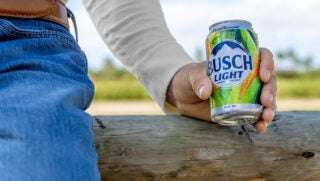This year an earlier than expected dry season has left some cattle producers without the green pastures they usually rely on. And last year’s drought leaves little hay to feed, putting producers in a rut.
“This early drought has caught many producers off guard,” said Kevin Glaubius, Director of Nutrition for BioZyme Inc. “And hay is becoming harder and harder to find, at least here in Missouri. I talked to one guy who paid $90 a bale on a Monday, and on Thursday paid $135 a bale for the same hay. With prices like those, it might be smarter to start feeding a little grain.”
Spring-calving cows with month-old calves in April are in their highest requirement period for both energy and protein in May. They are likely a month or two into nursing their new calf and getting ready to be bred back. A lack of nutrients now is critical not only to their reproductive performance, but also to their calf’s performance. A nutrient deficiency could delay the cow’s cycle, meaning they breed back later. Lowered milk production now can decrease weaning weights of their current calf crop meaning fewer pounds to wean this fall.
What cattle producers choose to do now for the next 3-4 weeks may have a significant impact on both the cow’s reproductive performance and that of her calf’s. The most important consideration according to Glaubius is to work with your nutritionist ensure that the cow gets adequate energy and protein.
He suggests three considerations for producers.
First, is to delay turnout on grass and continue to feed hay. This is going to be the most expensive option, as hay is scarce, and therefore expensive, in many parts of the country.
Second, Glaubius suggests supplementing the hay with grain. Since this is just a short-term solution until the pastures are ready, producers need to keep forage in the diet for good health. He said about 6 pounds of grain will replace 12 pounds of forage, making it a more economically feasible option.
“Grain has 2-3 times as much energy as hay. If you feed 5-10 pounds of grain per day instead of 20 pounds of forage, especially at current hay prices, that is economically smart,” Glaubius said. “In the ideal situation, I would hope that most producers have enough hay that they can supplement energy with 3-6 pounds of corn or soyhulls and not have to go to higher levels before the pasture is ready. This will help maintain the rumen microbes by keeping a fair amount of forage in the diet.”
He reminds cattle producers they can stretch their hay and make it last longer if they fork it to their cattle twice a day instead of feeding to them free-choice. This will help them save some hay for late summer or early fall, when they may see the need for hay sooner than anticipated again. When you roll out a bale of hay for cows as much as 20-30 percent can go to waste.
The third, and potentially best option, is to turn the cows out to pasture and supplement them with some grain. Glaubius recommends adding about 6 pounds of a grain-mix to the cows’ diet each day to take some pressure from the pasture. As the weather warms and the grass grows, decrease to 4 pounds of grain, and hopefully by the end of May, the grass will be growing like anticipated, and keeping up with cows so you can discontinue grain altogether.
“We normally don’t recommend feeding grain, but it may be a year that it pays for 21-30 days, until our forage can get back into production,” Glaubius said.
If you do turn your cows out before the grass is ready, don’t put hay out. The advantage with a little daily grain is you can generally keep the cows coming for a few pounds of corn on a daily basis while they just turn their nose up at hay when on green grass.
Be sure to work with a nutritionist to decide what to put in the grain mix. Corn, oats, and soybean hull pellets and corn gluten pellets carry better energy than forage. But the nutritionist will know what is best for your geographic area and for your herd.
A final recommendation is to add a quality VitaFerm supplement with Amaferm to the herd. Amaferm is a natural prebiotic designed to maximize the nutritional value of the feed. Amaferm helps increase digestibility and maximize absorption of the available feedstuffs, which should allow for some extra time on grass this summer, so cattle producers are not scrambling this fall.


